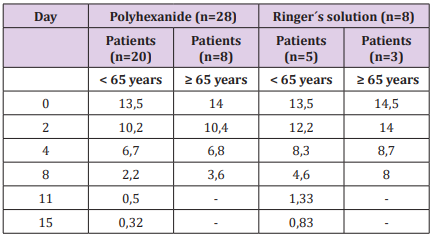Activity of the Antiseptic Polyhexanide Comparing Younger and Elderly Patients
Introduction
The care of geriatric patients is nowadays increasingly important, including the fight against infectious diseases. In the elderly patient, infections are usually more severe than in young people and end more often lethal. This can be due to many causes. The immune system ages, affecting both cell-mediated and humoral immunity. In addition, malnutrition, impaired organ function, and eventual polymedication play a significant role. As part of surgical procedures, the geriatric patient is at particular risk of infection. Patients 65 years or older have a 2.5-fold increased risk of infection complications. Respiratory and urinary tract infections, but also postoperative wound infections, occur more frequently in this age group. Postoperative wound infection accounts for around 17 % of nosocomial infection and affects 2 - 5 % of patients after surgery [1].Antiseptics are effective against a broad spectrum of germs. They are characterized by a low development of resistance. The use of antiseptics has therefore come to the fore in the local treatment of infections.
The antiseptic polyhexanide has been shown to be more bactericidal and tissue compatible than other antiseptics. In a first placebo-controlled, prospective, and randomized double-blind study on patients with bacteria-contaminated wound types 2-4, no deterioration of wound healing was observed in either group[2]. Polyhexanide also led to a significant reduction in micro-organisms on soft-tissue wound surfaces [3]. In order to assess the suitability of polyhexanide for elderly patients, a reevaluation of these findings was performed. The results of patients younger than 65 years were compared with those who were older.
The study was performed in accordance with the declaration of Helsinki. Patients (n=36) were admitted to the study with a bacterially contaminated or infected soft tissue wound of type 2 (clean contaminated after radical debridement), type 3 (still contaminated) or type 4 (dirty i.e. purulent wound)[4]. The age of the patients ranged from 19 to 89 years. Results of patients younger than 65 years (n=28) and 65 years or older (n=8) were analyzed separately. After a clinical evaluation a measurement of the wound area in cm2 and a photographic documentation of the baseline status were performed. A standardized collection of a swab specimen was taken and the size of the wound was determined by planimetry. Wound dressing was applied using cotton dressing pads moistened with Ringer´s or polyhexanide solution. An aqueous stock solution of 20 % polihexanide and 1% macrogolum was prepared ready for use by adding 2 ml of the mixture to 1000 ml Ringer solution (0.2%), giving a dilution of 0.4 mg/ml for the active ingredient polihexanide.
As previously described standardized swabs were taken on days 0, 2, 8 and 15 and investigated for microorganisms by routine procedures. The number of colony forming units (CFU) was determined by a serial dilution technique [3].
As expected from the previous investigations the wound score improved in general faster in the polyhexanide group than in the Ringer´s solution group. This could also be clearly observed in the subgroups of patients with different age (Table 1). The most frequently found pathogenic microorganism was Staphylococcus aureus, which was isolated from 8 wounds. Further isolates were Pseudomonas aeruginosa, Pseudomonas stutzeri, Pseudomonas stutzeri, Acinetobacter baumannii, Enterobacter sp., Klebsiella pneumoniae, Morganella morganii, beta-haemolytic streptococci, Enterococcus sp., Streptomyces griseus, and Candida sp. Isolates of the Staphylococcus epidermidis group and Bacillus sp. were regarded as apathogenic. The use of polyhexanide led to a faster reduction in microorganisms on the wound surfaces. With the exception of one patient the number of CFU per cm2 wound remained constant or decreased, in contrast to the wounds treated with Ringer´s solution. This was true for younger and elderly patients.
 Discussion
DiscussionA number of other clinical studies have confirmed the efficacy of polyhexanide [5-16]. It also has antiseptic properties against methicillin-resistant Staphylococcus aureus and vancomycinresistant enterococci [17-19]. Polyhexanide can be used for wound irrigation. It is also applicable to critically colonized and infected chronic wounds including burns and can be used for wound instillation in combination with negative pressure (negative pressure wound therapy). In contrast to Ringer’s solution in acute traumatic wounds, it showed a significant decrease in CFUs at 60 min [20]. In patients with chronic wounds (foot or leg ulcers) polyhexanide dressings reduced bacterial colonization and chronic wound pain after 5 weeks in comparison to dressings without polyhexanide [21]. Compared to a NaCl solution, more efficacy was achieved in reducing inflammatory signs and accelerating the healing of vascular leg ulcers and pressure ulcers [22]. In this study the application on elderly patients was investigated in particular. The current results suggest that polyhexanide is also effective for the use in elderly patients.
More BJSTR Articles : https://biomedres01.blogspot.com


No comments:
Post a Comment
Note: Only a member of this blog may post a comment.